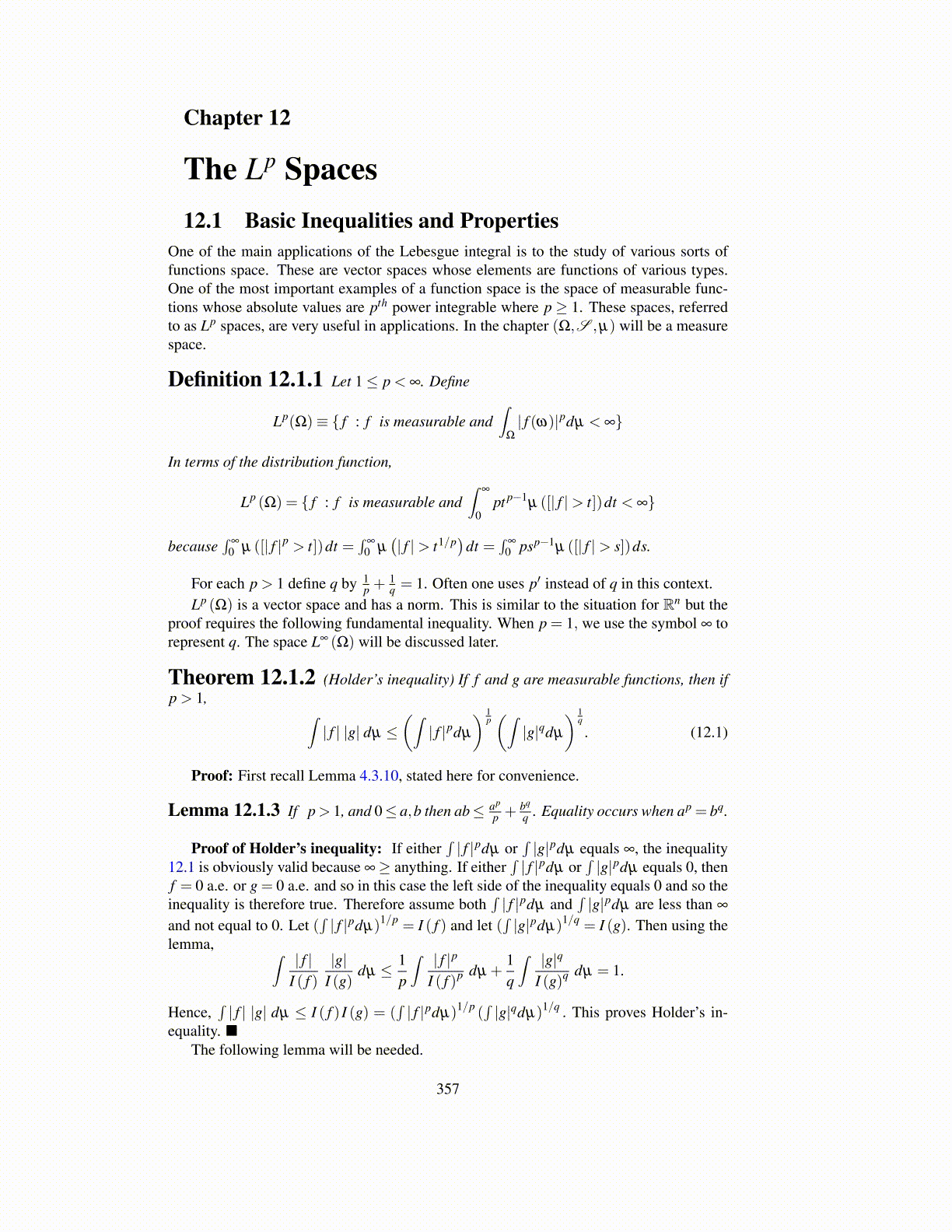
Chapter 12
The Lp Spaces12.1 Basic Inequalities and Properties
One of the main applications of the Lebesgue integral is to the study of various sorts offunctions space. These are vector spaces whose elements are functions of various types.One of the most important examples of a function space is the space of measurable func-tions whose absolute values are pth power integrable where p ≥ 1. These spaces, referredto as Lp spaces, are very useful in applications. In the chapter (Ω,S ,µ) will be a measurespace.
Definition 12.1.1 Let 1≤ p < ∞. Define
Lp(Ω)≡ { f : f is measurable and∫
Ω
| f (ω)|pdµ < ∞}
In terms of the distribution function,
Lp (Ω) = { f : f is measurable and∫
∞
0pt p−1
µ ([| f |> t])dt < ∞}
because∫
∞
0 µ ([| f |p > t])dt =∫
∞
0 µ(| f |> t1/p
)dt =
∫∞
0 psp−1µ ([| f |> s])ds.
For each p > 1 define q by 1p +
1q = 1. Often one uses p′ instead of q in this context.
Lp (Ω) is a vector space and has a norm. This is similar to the situation for Rn but theproof requires the following fundamental inequality. When p = 1, we use the symbol ∞ torepresent q. The space L∞ (Ω) will be discussed later.
Theorem 12.1.2 (Holder’s inequality) If f and g are measurable functions, then ifp > 1, ∫
| f | |g| dµ ≤(∫| f |pdµ
) 1p(∫|g|qdµ
) 1q
. (12.1)
Proof: First recall Lemma 4.3.10, stated here for convenience.
Lemma 12.1.3 If p> 1, and 0≤ a,b then ab≤ ap
p + bq
q . Equality occurs when ap = bq.
Proof of Holder’s inequality: If either∫| f |pdµ or
∫|g|pdµ equals ∞, the inequality
12.1 is obviously valid because ∞≥ anything. If either∫| f |pdµ or
∫|g|pdµ equals 0, then
f = 0 a.e. or g = 0 a.e. and so in this case the left side of the inequality equals 0 and so theinequality is therefore true. Therefore assume both
∫| f |pdµ and
∫|g|pdµ are less than ∞
and not equal to 0. Let (∫| f |pdµ)1/p = I ( f ) and let (
∫|g|pdµ)1/q = I (g). Then using the
lemma, ∫ | f |I ( f )
|g|I (g)
dµ ≤ 1p
∫ | f |p
I ( f )p dµ +1q
∫ |g|q
I (g)q dµ = 1.
Hence,∫| f | |g| dµ ≤ I ( f ) I (g) = (
∫| f |pdµ)1/p (
∫|g|qdµ)1/q . This proves Holder’s in-
equality. ■The following lemma will be needed.
357